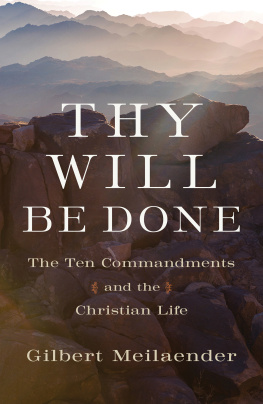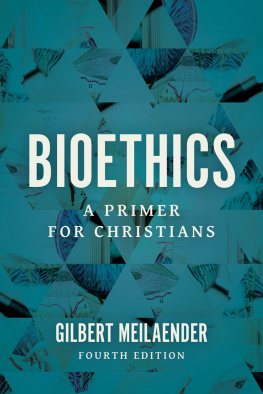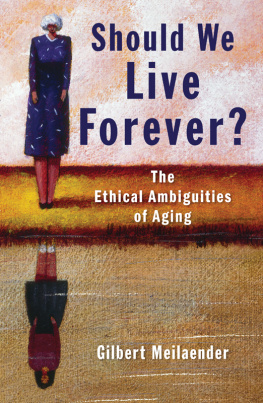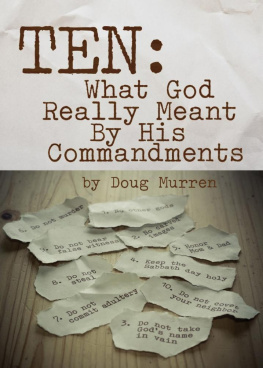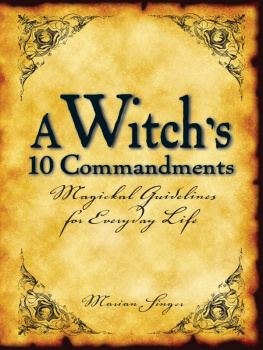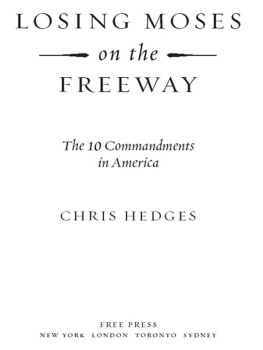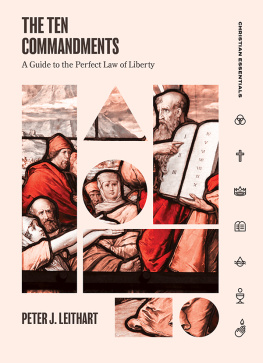1. The Law of Christ
2. The Marriage Bond
3. The Family Bond
4. The Life Bond
5. The Possessions Bond
6. The Speech Bond
7. The Great and First Commandment
Preface
In the pages that follow I do not aim at anything especially creative. Instead, I simply want to do what Christians have done many times beforenamely, think about the Christian life in terms of the Ten Commandments, the Decalogue. As John Calvin says in the Institutes , the purpose of the Decalogue is that we may express the image of God in our lives. To think through the shape of such a life is my aim in what follows.
To be sure, the Bible does not exactly contain a list of ten commandments. The commandments appear as an unnumbered list in chapter 20 of Exodus and chapter 5 of Deuteronomy, and the account in Exodus begins with the simple statement, God spoke all these words. Yet, for centuries not only Christians but also Jews have numbered the commandments as ten. More exactly we may speak of the ten words (which in Greek became deka logous , and in English Decalogue). Because God is said to have written these ten words on two stone tablets, it has also been common to divide them into two tablesthe first treating our relation to God, the second our relation to one another. Useful as that division can be in certain respects, my own discussion draws the second and third commandments into close connection with the bonds of community to which the commandments of the second table point.
While it has been common to number the commandments as ten, the precise way of numbering them varies. I doubt whether there is any way to demonstrate that one numbering must be preferred to another. I will follow the numbering that has been used by Roman Catholics and Lutherans. For this approach the first table consists of three commandmentsto have no other gods, not to use Gods name in vain, and to sanctify the holy day. The second table then enjoins honoring ones father and mother and prohibits unjustified killing, adultery, theft, false testimony, and coveting (first of the neighbors house; then of the neighbors wife, servants, or possessions).
The principal Christian alternative to this numbering is that used by the Eastern Orthodox churches and many Protestant bodies. That alternative treats the prohibition of graven images, which is not an independently numbered commandment for Roman Catholics and Lutherans, as the second commandmentgiving four commandments in the first table. If the total number is still to be ten, the second table must be compressed into six commandments. The Orthodox and many Protestants accomplish this by combining the commandments that forbid coveting into one, whereas they remain separate (as the ninth and tenth) in the Roman Catholic and Lutheran Decalogue. The traditional Jewish numbering provides yet a third alternative, which is distinguished chiefly by the fact that the prologue, which identifies the One who gives these commands as the God who brought Israel out of Egypt, is numbered as the first commandment.
Not a lot hangs on this for me since, as will eventually be apparent, I treat the seventh, ninth, and tenth commandments together as aspects of what I will call the possessions bond. More generally, I use all the commandments after the first as an invitation to reflect upon the importance of five different bonds that unite human beings in community: the marriage bond, the family bond, the life bond, the possessions bond, and the speech bond.
Clearly, however, the first commandment does have a special place. Quite rightly, therefore, Martin Luther emphasized the manner in which all other commandments relate to the first. To have no other godsto love and trust God above all elseenables a person to keep the other commandments. And something like the reverse may also be true. For it is in and through the various bonds connecting human lives that God works on us, beginning to make of us people who can love him with the whole of our heart, soul, strength, and mind.
Nevertheless, the connection between the first commandment and the others can also create difficulties for the Christian life. There is tension between the first commandment and the bonds of life to which the other commandments point. How exactly shall we reconcile the requirement that we love God wholly and above all else with the fact that our hearts are rightly given in love to others and other good things within the five bonds of human life? This creates tension within the Christian life and points to an enduring problem for Christian thought.
The commandments are, I think, best thought of within the full sweep of the biblical story. Thus, in the massive and never-completed volumes of his Church Dogmatics , Karl Barth envisions ethics as offering an account of human action that corresponds to the threefold form of Gods action in creation, reconciliation, and redemption. there must be some account that accepts, honors, and celebrates distinctively human agency. Because we are sinners whose lives are disordered and in need of healing, God has in Jesus acted to reconcile us to himself. And because we are heirs of the future God has promised, we will one day be perfected in a way that does not obliterate our created humanity but, rather, expresses Gods faithfulness to it.
Without attempting in any way to do justice to the richness of Barths lavishly developed structure, I suggest that Christian reflection on the moral instruction in the Decalogue cannot ignore any of these angles of vision if we truly want to pray, Thy will be done. The three angles of vision do not simply follow one another in lockstep sequence, nor does any one of them ever replace another. But even if it is difficult to combine the three, it is still important, as Barth put it, to recall that in ethics our task is to accompany this history of God and man from creation to reconciliation and redemption, indicating the mystery of the encounter at each point on the path according to its own distinctive character.
. John Calvin, Institutes of the Christian Religion , ed. John T. McNeill, trans. Ford Lewis Battles, Library of Christian Classics 20 (Philadelphia: Westminster, 1960), 2.8.51. All quotations from the Institutes are from this translation.
. Barth himself provides a succinct description of his approach in three places: (1) Church Dogmatics II/2, 54950; (2) Church Dogmatics III/4, 2426; and (3) pp. 611 of The Christian Life , a fragment of the unfinished discussion of the ethics of reconciliation in Church Dogmatics IV.
. Karl Barth, Church Dogmatics III/4, ed. G. W. Bromiley and T. F. Torrance, trans. A. T. Mackay et al. (Edinburgh: T&T Clark, 1961), 26.

